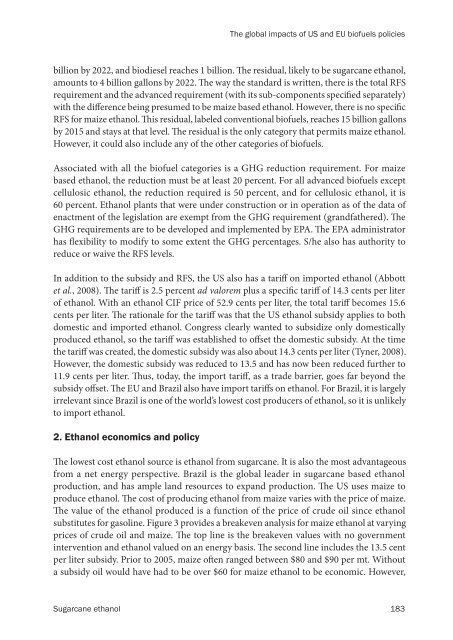Sugarcane ethanol: Contributions to climate change - BAFF
Sugarcane ethanol: Contributions to climate change - BAFF
Sugarcane ethanol: Contributions to climate change - BAFF
Create successful ePaper yourself
Turn your PDF publications into a flip-book with our unique Google optimized e-Paper software.
The global impacts of US and EU biofuels policies<br />
billion by 2022, and biodiesel reaches 1 billion. �e residual, likely <strong>to</strong> be sugarcane <strong>ethanol</strong>,<br />
amounts <strong>to</strong> 4 billion gallons by 2022. �e way the standard is written, there is the <strong>to</strong>tal RFS<br />
requirement and the advanced requirement (with its sub-components speci�ed separately)<br />
with the di�erence being presumed <strong>to</strong> be maize based <strong>ethanol</strong>. However, there is no speci�c<br />
RFS for maize <strong>ethanol</strong>. �is residual, labeled conventional biofuels, reaches 15 billion gallons<br />
by 2015 and stays at that level. �e residual is the only category that permits maize <strong>ethanol</strong>.<br />
However, it could also include any of the other categories of biofuels.<br />
Associated with all the biofuel categories is a GHG reduction requirement. For maize<br />
based <strong>ethanol</strong>, the reduction must be at least 20 percent. For all advanced biofuels except<br />
cellulosic <strong>ethanol</strong>, the reduction required is 50 percent, and for cellulosic <strong>ethanol</strong>, it is<br />
60 percent. Ethanol plants that were under construction or in operation as of the data of<br />
enactment of the legislation are exempt from the GHG requirement (grandfathered). �e<br />
GHG requirements are <strong>to</strong> be developed and implemented by EPA. �e EPA administra<strong>to</strong>r<br />
has �exibility <strong>to</strong> modify <strong>to</strong> some extent the GHG percentages. S/he also has authority <strong>to</strong><br />
reduce or waive the RFS levels.<br />
In addition <strong>to</strong> the subsidy and RFS, the US also has a tari� on imported <strong>ethanol</strong> (Abbott<br />
et al., 2008). �e tari� is 2.5 percent ad valorem plus a speci�c tari� of 14.3 cents per liter<br />
of <strong>ethanol</strong>. With an <strong>ethanol</strong> CIF price of 52.9 cents per liter, the <strong>to</strong>tal tari� becomes 15.6<br />
cents per liter. �e rationale for the tari� was that the US <strong>ethanol</strong> subsidy applies <strong>to</strong> both<br />
domestic and imported <strong>ethanol</strong>. Congress clearly wanted <strong>to</strong> subsidize only domestically<br />
produced <strong>ethanol</strong>, so the tari� was established <strong>to</strong> o�set the domestic subsidy. At the time<br />
the tari� was created, the domestic subsidy was also about 14.3 cents per liter (Tyner, 2008).<br />
However, the domestic subsidy was reduced <strong>to</strong> 13.5 and has now been reduced further <strong>to</strong><br />
11.9 cents per liter. �us, <strong>to</strong>day, the import tari�, as a trade barrier, goes far beyond the<br />
subsidy o�set. �e EU and Brazil also have import tari�s on <strong>ethanol</strong>. For Brazil, it is largely<br />
irrelevant since Brazil is one of the world’s lowest cost producers of <strong>ethanol</strong>, so it is unlikely<br />
<strong>to</strong> import <strong>ethanol</strong>.<br />
2. Ethanol economics and policy<br />
�e lowest cost <strong>ethanol</strong> source is <strong>ethanol</strong> from sugarcane. It is also the most advantageous<br />
from a net energy perspective. Brazil is the global leader in sugarcane based <strong>ethanol</strong><br />
production, and has ample land resources <strong>to</strong> expand production. �e US uses maize <strong>to</strong><br />
produce <strong>ethanol</strong>. �e cost of producing <strong>ethanol</strong> from maize varies with the price of maize.<br />
�e value of the <strong>ethanol</strong> produced is a function of the price of crude oil since <strong>ethanol</strong><br />
substitutes for gasoline. Figure 3 provides a breakeven analysis for maize <strong>ethanol</strong> at varying<br />
prices of crude oil and maize. �e <strong>to</strong>p line is the breakeven values with no government<br />
intervention and <strong>ethanol</strong> valued on an energy basis. �e second line includes the 13.5 cent<br />
per liter subsidy. Prior <strong>to</strong> 2005, maize o�en ranged between $80 and $90 per mt. Without<br />
a subsidy oil would have had <strong>to</strong> be over $60 for maize <strong>ethanol</strong> <strong>to</strong> be economic. However,<br />
<strong>Sugarcane</strong> <strong>ethanol</strong> 183












